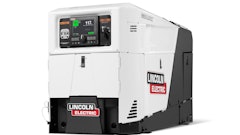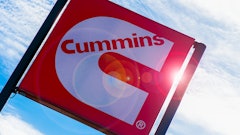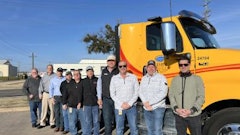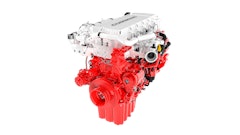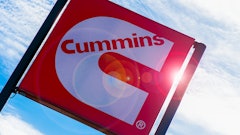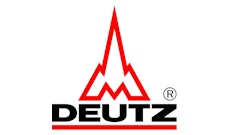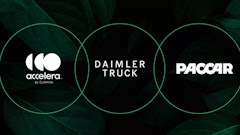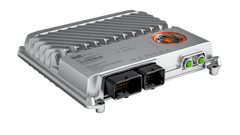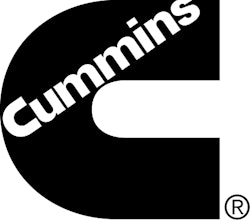
Cummins will reveal electrified power technology for transit bus applications at the APTA public transportation show opening in Atlanta on October 9.
Cummins will display a new powertrain, configurable for either a full battery electric vehicle (BEV) or a range extended electric vehicle (REEV) incorporating a compact engine-generator. Cummins electrified power systems are ideally suited for integration into transit, shuttle and commuter buses enabling direct drive-by-wire continuous acceleration. With the bus operating in battery-only mode, the system achieves zero emissions at the point of use.
Enhanced energy storage for both the BEV and REEV systems is achieved using Cummins’ high-density battery enclosure, which are compact and modular allowing for both on-roof and chassis integration. Cummins’ unique design fits into existing bus designs.
Cummins’ proprietary control technology enables the zero-emissions bus range to be extended by optimally managing subsystems, allowing the charge of the battery to be extended. Operational flexibility is also improved with fast recharge capability using a plug-in connection, as well as options for en-route charging when a pantograph or charge plate infrastructure is available.
“The introduction of our new BEV and REEV systems will complement Cummins’ clean-diesel, near-zero natural gas and diesel-hybrid products to offer the broadest, most energy-diverse power portfolio in the bus industry. We are able to meet the needs of every transit route, every duty cycle and every emissions standard in the most cost-effective manner,” says Julie Furber, Executive Director, Electrification Business, Cummins Inc.
The standard-size Cummins battery enclosure provides a 70 kWh storage capability with up to eight enclosure units (560 kWh) suited for installation within the BEV bus. This enables a zero-emissions range of up to 224 miles on a single charge, with an energy consumption of 25 mpg diesel, which provides significant cost reductions.
Cummins' REEV system has a battery pack of three enclosures (210 kWh) which can provide a zero-emissions range of up to 84 miles — a significant advantage over current hybrid bus capability. When the battery pack depletes to a low state-of-charge, the REEV system brings online a 150 kW (201 hp) engine-generator to recharge the batteries and continue operations with ultra-low emissions capability.
Compared to the standard diesel-powered bus, the REEV 4.5-L engine is downsized by about 50% in terms of displacement and can achieve up to 10 mpg, significantly lowering the carbon footprint. A power assist function is available from the battery pack whenever the system needs additional energy.
The REEV system’s ability to switch between shorter-range battery-only mode and extended-range generator mode allows transit authorities to geofence specific downtown areas by utilizing Cummins over-the-air connected technology. The REEV system also enables buses to travel significant distances beyond the city charging infrastructure.
“A key focus in the design of both our BEV and REEV systems ensures the electrified architecture is modular and adaptable to enable an easier technology transition for bus manufacturers,” says Brian Wilson, Cummins General Manager — Global Bus Business. “This allows transit authorities to continue using the same preferred bus models and retain fleet commonality.”
“The new systems will be expertly serviced and supported by Cummins’ distribution network the same way we currently provide 24/7 support for our diesel-, hybrid- and natural-gas-powered fleets. This is an important factor for transit authorities, because as they adopt new technologies they can count on Cummins to help with a transition to BEV and REEV technology,” adds Wilson.
Energy Efficiency
The BEV and REEV systems incorporate the same traction motor and power electronics to deliver a continuous torque output of 1,850 Nm (1,365 lbs.-ft.), eliminating the need for gear shifting and dramatically reducing powertrain noise. When the vehicle requires additional tractive power during rapid acceleration or while climbing gradients, the system can deliver an instant peak torque boost of up to 3,400 Nm (2,508 lbs.-ft.) for a short period.
Both systems provide a continuous electrical output of 225 kW (302 hp), increasing to a peak output of 350 kW (469 hp) when it senses the need for a power boost. The high-voltage system operates at a nominal 660V when battery state-of-charge is around 50%.
Battery energy storage levels are boosted on-route by accepting “free” energy recovered through regenerative braking. On a frequent stop/start bus duty cycle, this could contribute the equivalent of 20% to the total state-of-charge.
Electrical energy is also exportable from the Cummins system to all electric-powered accessories featured on the bus, such as e-power steering, e-HVAC, e-air compressors and e-cooling fans, adding up to a typical 25 kW (33 hp) load at any one time. The electrical supply from the Cummins system can be both low-voltage DC and high-voltage AC, helping to simplify the installation and lower the cost of the e-accessories package.
The same electronic control module used on the popular L9, L9N and B6.7 bus engines is adapted for use as the BEV and REEV system controller, offering familiar diagnostics and the connectivity that bus operators experience today.









